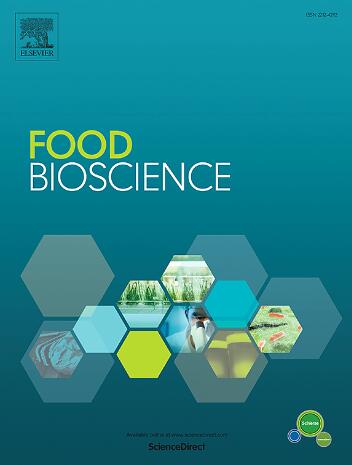在米曲霉发酵豆粕过程中加入大豆分离蛋白水解物,可促进后续水解过程中鲜味成分的释放
IF 5.9
1区 农林科学
Q1 FOOD SCIENCE & TECHNOLOGY
引用次数: 0
摘要
本研究旨在利用米曲霉对豆粕进行固态发酵,然后进行酶解,开发出鲜味增强剂。发酵豆粕酶解液具有显著的鲜味和增味能力。发酵前添加大豆分离蛋白水解物(SPIH)可提高发酵体系中中性蛋白酶、碱性蛋白酶、酸性蛋白酶、氨基肽酶和谷氨酰胺酶的活性,增加鲜味活性肽/氨基酸的释放,从而提高发酵豆粕(FSHE)最终水解液的鲜味强度和增味能力。与不含spih的发酵豆粕(FSHC)最终水解液相比,FSHE的Asp、Glu、ME、EV、EA和EA分别提高了10.0%、6.6%、54.5%、75.2%、232.0%和17.5%。鲜味成分在FSHE中生成的关键阶段是酶解的前8 h, SPIH主要影响鲜味成分的释放。FSHE中小于1000 Da的肽段和1000 ~ 3000 Da的肽段分别在酶解前8 h和12 h快速增加了FSHE的鲜味强度和增强鲜味能力。FSHE鲜味特性受游离氨基酸(Glu和Asp)、肽氨基酸(Glu和Asp)和增味肽(ME、EL、EA和EV)的影响。除了中性蛋白酶、碱性蛋白酶和酸性蛋白酶外,米曲霉的氨基肽酶和谷氨酰胺酶也是FSHE鲜味成分产生的关键酶。本文章由计算机程序翻译,如有差异,请以英文原文为准。

Soybean protein isolate hydrolysate addition during fermentation of soybean meal with Aspergillus oryzae enhances the release of umami components in subsequent hydrolysis process
This research aimed to develop umami enhancers through solid-state fermentation of soybean meal with Aspergillus oryzae then enzymatic hydrolysis. The enzymatic hydrolysate of fermented soybean meal possessed significant umami taste and umami-enhancing capacity. Addition of soybean protein isolate hydrolysate (SPIH) before fermentation enhanced the fermentation system's neutral protease, alkaline protease, acidic protease, aminopeptidase and glutaminase activities, increased the release of umami-active peptides/amino acids, thereby enhancing the umami intensity and umami-enhancing capacity of the final hydrolysate of fermented soybean meal (FSHE). The peptide Asp, peptide Glu, ME, EV, EA, and EA of FSHE showed improvements of 10.0 %, 6.6 %, 54.5 %, 75.2 %, 232.0 %, and 17.5 %, respectively, compared to the SPIH-free final hydrolysate of fermented soybean meal (FSHC). The critical stage for generating umami components in FSHE was the first 8 h of enzymatic hydrolysis, and SPIH mainly affected the release of umami components during this period. The peptides smaller than 1000 Da and peptide sized 1000–3000 Da in the FSHE accounted mainly for rapid increase of FSHE's umami intensity and umami-enhancing capacity during the first 8 and 12 h of enzymatic hydrolysis, respectively. FSHE's umami characteristics were influenced by free amino acids (Glu and Asp), peptide amino acids (Glu and Asp), and umami-enhancing peptides (ME, EL, EA and EV). Besides neutral protease, alkaline protease and acidic protease, aminopeptidase and glutaminase from Aspergillus oryzae were also the key contributing enzymes to the production of umami components in FSHE.
求助全文
通过发布文献求助,成功后即可免费获取论文全文。
去求助
来源期刊

Food Bioscience
Biochemistry, Genetics and Molecular Biology-Biochemistry
CiteScore
6.40
自引率
5.80%
发文量
671
审稿时长
27 days
期刊介绍:
Food Bioscience is a peer-reviewed journal that aims to provide a forum for recent developments in the field of bio-related food research. The journal focuses on both fundamental and applied research worldwide, with special attention to ethnic and cultural aspects of food bioresearch.
 求助内容:
求助内容: 应助结果提醒方式:
应助结果提醒方式:


